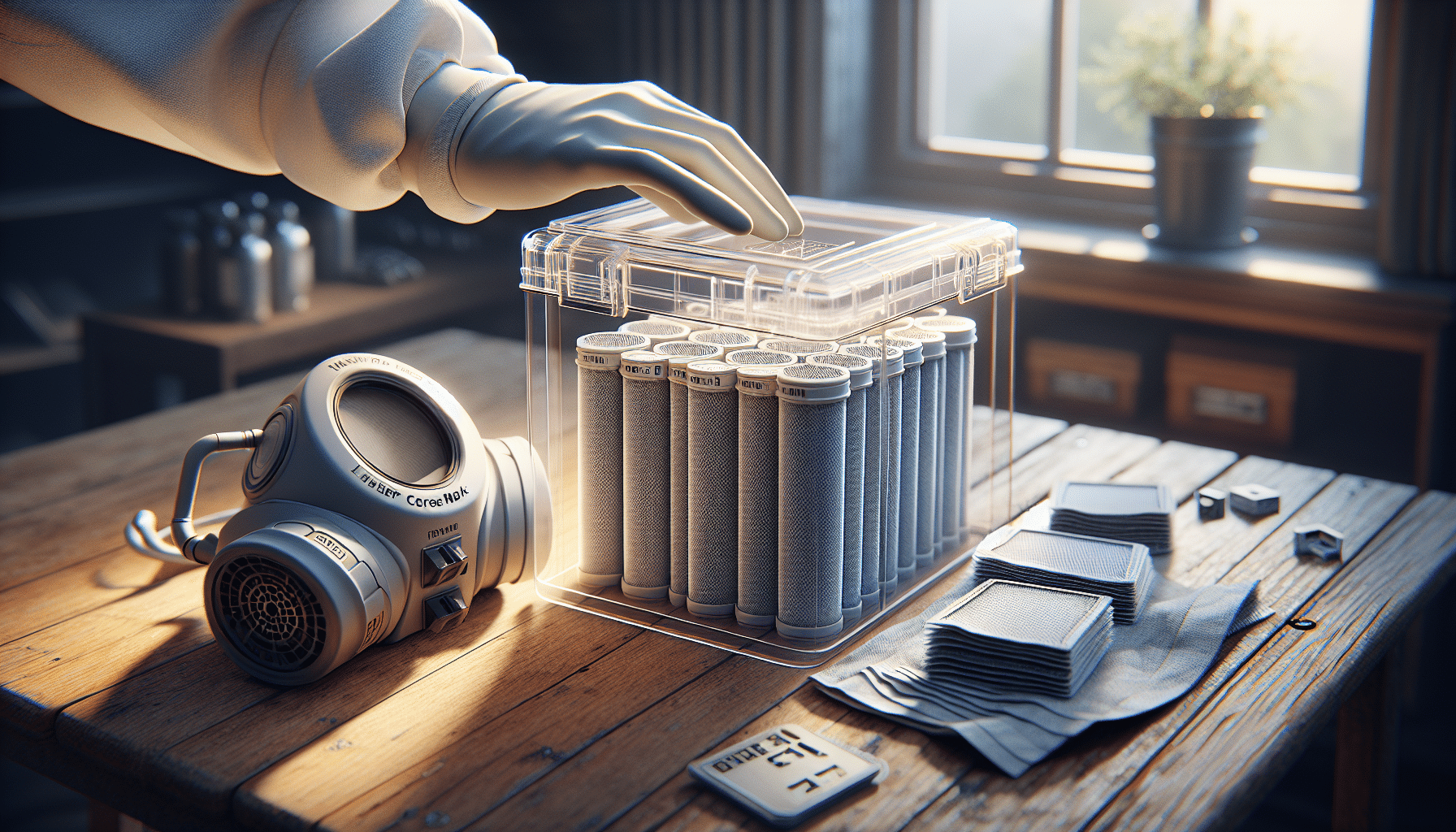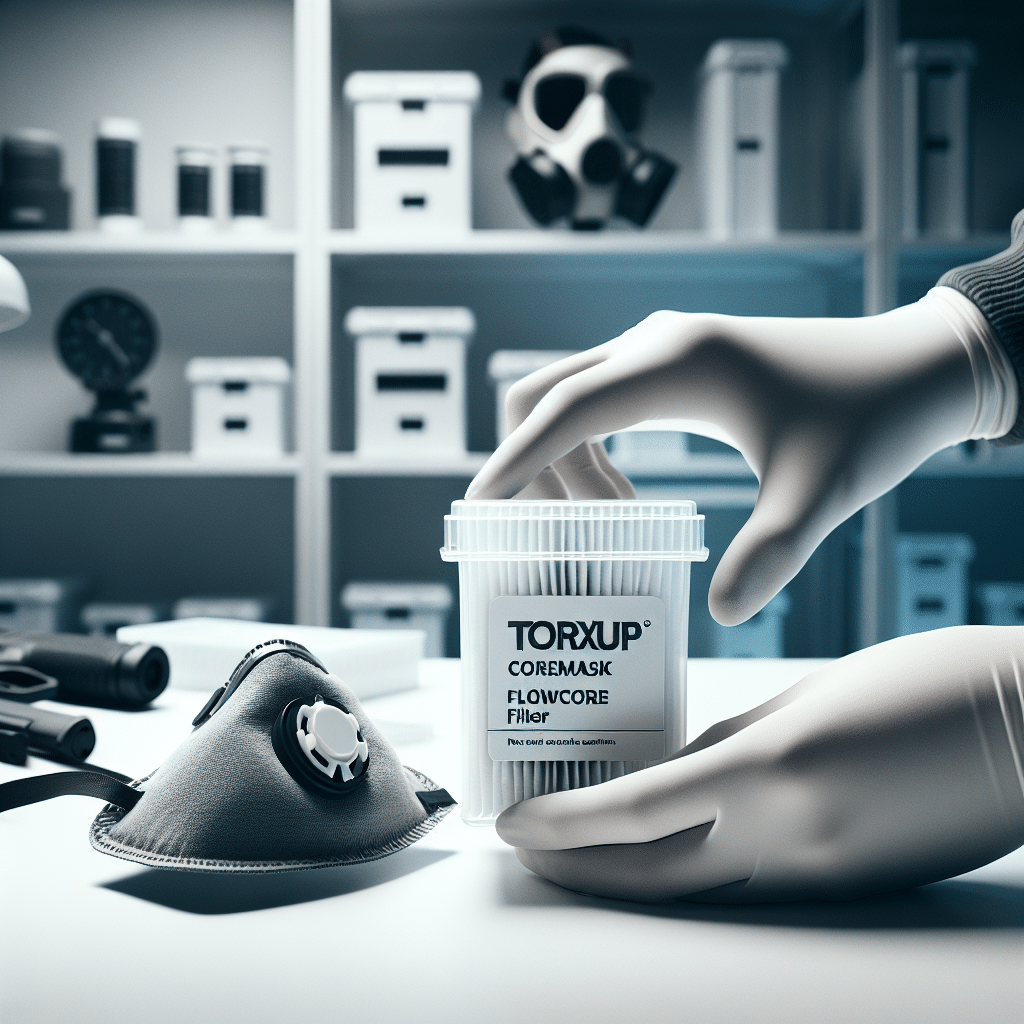Extend FlowCore Filter Life: Storage & Care Tips for Torxup CoreMask
In This Article
- Always store unused filters in airtight containers away from light, heat, and moisture.
- Inspect filters for damage or odour before every reuse, and maintain a log of usage details.
- Never wash FlowCore filters or expose them to extreme environmental conditions.
- Implement a regular mask maintenance schedule to ensure compatibility and fit.
- Discard filters immediately upon any sign of physical degradation or increased resistance.
Why Filter Maintenance Matters
Health, Efficiency & Cost Saving
FlowCore filter maintenance is essential to ensuring the continued efficiency and safety of your respiratory protection system. These advanced filters are engineered to provide exceptional filtration capabilities against particulate matter, but without regular care, their performance deteriorates. Poorly maintained filters can lead to significantly reduced protection, compromised breathing resistance, and greater long-term costs.
By following best practices in FlowCore filter maintenance, users can prolong filter life, minimise exposure to harmful pollutants, and reduce the frequency of replacements. Especially in professional environments such as laboratories, healthcare centres, industrial settings, and construction zones, where air quality standards are critical, keeping filters in optimal condition is non-negotiable. Not only does this practice ensure health and safety, but it also enhances the economic value of your investment in high-performance respiratory systems. Learn more about Dust Mask and Respirator Maintenance

How to Store Unused FlowCore Filters Properly
Best Practices for Longevity
Proper storage of unused FlowCore filters extends their functional life and maintains filtration integrity. First and foremost, ensure that clean, unused filters are kept sealed in their original packaging whenever possible. These pouches are designed to be airtight, protecting the filters from ambient humidity, dust, and other microparticles.
If the original packaging has been compromised or discarded, place the filters in an airtight, waterproof container. Avoid using plastic bags that aren’t purpose-built for filter storage, as they offer little protection from UV degradation or humidity ingress.
It’s equally important to store filters in a cool, dry space, away from direct sunlight or heat emission sources such as radiators or electronics. Exposure to UV rays can degrade filter material over time, reducing its efficacy even before first use. A simple controlled environment, such as a labelled drawer in a temperature-regulated office or lab, makes a significant difference in longevity. Best practices for storing air filters longer
Reusing FlowCore Filters Safely
When and How It’s Safe to Reuse Filters
Reusability is one of the key advantages of today’s high-performance FlowCore filters. However, this must be balanced with responsible usage practices. A filter that has been used only briefly in a low-contaminant environment may reasonably be stored and reused. Conversely, filters used in high-exposure scenarios—such as welding, demolition, or pathogen-heavy zones—should be replaced after a single session.
Before reusing any filter, conduct a thorough visual inspection and ensure that it is free of damage, moisture, or significant discolouration. Smell the filter to detect any lingering unpleasant odours, which may indicate microbial or chemical contamination. Gently shake out any non-adhering particles, but avoid tapping or compressing the surface, as this may compromise filtration layers.
Store semi-used filters in separate, sealed containers clearly marked with the date of last use and usage context (e.g., “light woodworking – 2 hrs – no dust suppression”). This record helps prevent overuse and enables smarter inventory tracking, particularly in team environments where multiple users share filter stocks.
Signs Your Mask Filter Needs Replacement
What to Look For Before Reuse
Recognising the signs that a mask filter must be retired is crucial. One of the earliest indicators is increased breathing resistance. As particulate matter clogs the filter media, airflow becomes restricted. This sensation should not be ignored, as it signals that the filter is no longer functioning optimally.
Visual cues are also important. Significant discolouration, especially brown or grey tinting, often indicates trapped particulate saturation. Tears, frays, or punctures in the filter material mean immediate disposal is required. Likewise, filters that emit unpleasant odours—or that feel damp to the touch—should never be reused due to bacterial or fungal risks.
It’s advisable to establish protocols for routine assessment of each filter before every use. Light-use filters might survive 5–10 uses, while heavier-use filters may be limited to one or two. Always err on the side of caution to avoid compromising safety. Read a related article
Common Storage Mistakes to Avoid
Don’t Let Poor Handling Shorten Filter Life
Many well-intentioned users inadvertently reduce the life of their FlowCore filters through poor storage habits. One common mistake is leaving used filters in open-air spaces. This allows dust, moisture, and pollutants to accumulate even while the filter is idle. Another error is stacking or compressing filters during storage—doing so damages the internal fibres and compromises airflow fidelity.
Also, avoid placing filters directly into toolboxes or drawers shared with other equipment. Abrasive edges, tools, and even pens can puncture or deform the filter housing. Some users make the error of leaving their filters in hot vehicles or overexposed windowsills, where heat and UV rays speed up material degradation.
To prevent these problems, implement a disciplined “store-seal-log” method: store filters properly, seal them in breathable yet airtight packaging, and log usage frequency. These three actions together dramatically extend the lifespan of your filtration units.
Ideal Storage Containers for Filters
Choosing the Right Airtight Option
The best containers for storing FlowCore filters are those that combine airtight seals with structural integrity. Hard-shell plastic containers with a gasketed lid are ideal. They prevent filter deformation and block out both fine particles and ambient air moisture.
Look for food-grade plastic or medical storage cases that offer transparency for easy visual inspection of contents. Some filter users have also reported success using high-quality, resealable silicon pouches designed for laboratory tools. These provide flexible storage without sacrificing protection.
Also, ensure your containers allow some separation—filters should not be pressed against one another. Consider adding dividers or individual pods within larger cases. This organisation not only prevents cross-contamination but also helps track selection and usage more effectively. Common mistakes in equipment maintenance
Environmental Factors That Impact Filter Life
Temperature, Humidity, and Light
Three environmental variables have the most impact on FlowCore filter degradation: temperature, humidity, and light exposure. Excessive heat can melt or warp filter components, especially in models with blended polymer fibres. Humidity introduces moisture that may harbour bacterial growth even in unused filters.
Ultraviolet rays are especially damaging. Continuous light exposure—whether from sunlight or persistent artificial lighting—can break down filter materials, turning them brittle or discoloured. This degradation can silently reduce filtration efficiency before first use is ever attempted.
To mitigate these effects, store filters at stable room temperatures (ideally between 15–25°C), in dark or shaded conditions. Employ moisture-absorbing packets, like silica gel sachets, inside your storage vessels to regulate humidity. And rotate your stored filters regularly, using older units first before new ones to prevent prolonged stagnation.
Maintenance Tips for Torxup CoreMask
Care Guidance for Prolonging Filter Use
FlowCore filters are used within a broader mask ecosystem, most notably the Torxup CoreMask. Proper mask maintenance complements filter care. Clean the mask frame regularly using a mild, non-corrosive cleanser and warm water. A disinfectant wipe is sufficient between uses, while a deep clean is recommended weekly.
Inspect the mask-to-filter seal before each use. A broken or loose seal renders even the most pristine filter ineffective. Replace any degraded rubber or silicone sealing components as required. Storing your mask and filters together in one ventilated container helps maintain usability alignment while keeping both components protected.
Avoid abrasion inside the mask cavity where filters rest. Friction-based deterioration accelerates filter wear. For this reason, always insert and remove filters using gentle pressure, avoiding forceful snaps or bending actions.
FAQs From Our Community
What People Ask Most About Filter Storage
Q1: How long can an unused FlowCore filter be stored?
With ideal storage conditions (cool, dry, dark), unused FlowCore filters can last upwards of 12 months without degradation.
Q2: Can expired filters still be effective?
While expired filters may function in a limited way, their filtration guarantees are no longer valid. Only use them in non-critical environments after observation and testing.
Q3: Is it safe to wash FlowCore filters with water?
No. These filters are not designed to be washed. Cleaning with water can distort the internal structure and compromise filtration efficacy.
Q4: How many times can a typical FlowCore filter be reused?
This depends on usage context, but for light-duty protection, an average FlowCore filter may serve up to 5 uses if assessed and stored correctly.
Takeaways & Best Practices
Steps for Everyday Maintenance Success
FlowCore filter maintenance is not just an accessory task—it’s a core component of respiratory safety planning. Practising conscientious storage, reuse, and inspection can significantly extend your filters’ lifespan without endangering performance.
Adopting a reflexive habit of checking your filters daily, storing them properly, and discarding them when necessary ensures that both individual users and organisational teams operate at maximum safety and efficiency. These best practices not only prevent hazards but align with sustainable usage models that save costs and greenhouse gases related to filter production and transport.
“Since following this maintenance guide, our team has increased filter efficiency by 35% while reducing monthly replacements—impressive ROI.”
Conclusion: Maximise Every Filter
Regular, thoughtful FlowCore filter maintenance is the linchpin of respiratory safety, efficiency, and cost containment. From storage and inspection to informed reuse and environmental awareness, each action contributes significantly to filter longevity. In a world where respiratory threats abound, proactive filter care is not merely recommended—it’s essential.
Great guide on extend-flowcore-mask-filter-life-storage-guidance – Community Feedback
How should I store unused FlowCore filters?
Keep unused FlowCore filters in their original packaging, sealed, and in a cool, dry place away from direct sunlight and moisture.
Can used filters be reused after a break?
Yes, if the filters are not saturated or visibly contaminated. Store them in a clean, airtight container between uses to avoid moisture and dust ingress.
What shortens the life of a mask filter?
Exposure to moisture, dust, strong odours, and poor storage conditions rapidly reduce filter performance and lifespan.




